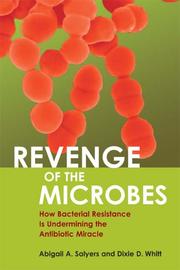| Listing 1 - 10 of 739 | << page >> |
Sort by
|
Periodical
Abstract | Keywords | Export | Availability | Bookmark
 Loading...
Loading...Choose an application
- Reference Manager
- EndNote
- RefWorks (Direct export to RefWorks)
Book
Year: 2021 Publisher: London : IntechOpen,
Abstract | Keywords | Export | Availability | Bookmark
 Loading...
Loading...Choose an application
- Reference Manager
- EndNote
- RefWorks (Direct export to RefWorks)
Staphylococcus aureus is a coccus, gram-positive, non-spore forming, and non-motile bacterium. Its commensal and opportunistic capabilities make it able to colonize different sites of animals and humans. Resistance to antibiotics has resulted in development of new strains and new types within strains. Types of methicillin-resistant S. aureus (MRSA) include hospital-acquired MRSA (HA-MRSA), community-acquired MRSA (CA-MRSA), and livestock-acquired MRSA (LA-MRSA). There are also new strains like vancomycin-resistant S. aureus (VRSA) and vancomycin-intermediate S. aureus (VISA). Expansion in resistance is expected to give rise to newer strains resistant to antibiotics such as macrolide (erm gene), tetracycline (tet genes), mupirocin (mupR), and fusidic acid (fusD). Alternative approaches like nanoparticles, bacteriophages, phytochemicals, and more are required to tackle this pathogen. This book contains information on epidemiology, resistance mechanisms, and alternative ways to curtail S. aureus infection, as well as future research opportunities.
Book
Year: 2021 Publisher: London : IntechOpen,
Abstract | Keywords | Export | Availability | Bookmark
 Loading...
Loading...Choose an application
- Reference Manager
- EndNote
- RefWorks (Direct export to RefWorks)
Staphylococcus aureus is a coccus, gram-positive, non-spore forming, and non-motile bacterium. Its commensal and opportunistic capabilities make it able to colonize different sites of animals and humans. Resistance to antibiotics has resulted in development of new strains and new types within strains. Types of methicillin-resistant S. aureus (MRSA) include hospital-acquired MRSA (HA-MRSA), community-acquired MRSA (CA-MRSA), and livestock-acquired MRSA (LA-MRSA). There are also new strains like vancomycin-resistant S. aureus (VRSA) and vancomycin-intermediate S. aureus (VISA). Expansion in resistance is expected to give rise to newer strains resistant to antibiotics such as macrolide (erm gene), tetracycline (tet genes), mupirocin (mupR), and fusidic acid (fusD). Alternative approaches like nanoparticles, bacteriophages, phytochemicals, and more are required to tackle this pathogen. This book contains information on epidemiology, resistance mechanisms, and alternative ways to curtail S. aureus infection, as well as future research opportunities.
Dissertation
Year: 1983 Publisher: Bleiswijk NKB Offset
Abstract | Keywords | Export | Availability | Bookmark
 Loading...
Loading...Choose an application
- Reference Manager
- EndNote
- RefWorks (Direct export to RefWorks)
Book
Year: 2021 Publisher: London : IntechOpen,
Abstract | Keywords | Export | Availability | Bookmark
 Loading...
Loading...Choose an application
- Reference Manager
- EndNote
- RefWorks (Direct export to RefWorks)
Staphylococcus aureus is a coccus, gram-positive, non-spore forming, and non-motile bacterium. Its commensal and opportunistic capabilities make it able to colonize different sites of animals and humans. Resistance to antibiotics has resulted in development of new strains and new types within strains. Types of methicillin-resistant S. aureus (MRSA) include hospital-acquired MRSA (HA-MRSA), community-acquired MRSA (CA-MRSA), and livestock-acquired MRSA (LA-MRSA). There are also new strains like vancomycin-resistant S. aureus (VRSA) and vancomycin-intermediate S. aureus (VISA). Expansion in resistance is expected to give rise to newer strains resistant to antibiotics such as macrolide (erm gene), tetracycline (tet genes), mupirocin (mupR), and fusidic acid (fusD). Alternative approaches like nanoparticles, bacteriophages, phytochemicals, and more are required to tackle this pathogen. This book contains information on epidemiology, resistance mechanisms, and alternative ways to curtail S. aureus infection, as well as future research opportunities.

ISBN: 1555812988 9781555812980 Year: 2005 Publisher: Washington, D.C.: ASM,
Abstract | Keywords | Export | Availability | Bookmark
 Loading...
Loading...Choose an application
- Reference Manager
- EndNote
- RefWorks (Direct export to RefWorks)
Periodical
Abstract | Keywords | Export | Availability | Bookmark
 Loading...
Loading...Choose an application
- Reference Manager
- EndNote
- RefWorks (Direct export to RefWorks)
Periodical
Abstract | Keywords | Export | Availability | Bookmark
 Loading...
Loading...Choose an application
- Reference Manager
- EndNote
- RefWorks (Direct export to RefWorks)
Periodical
Abstract | Keywords | Export | Availability | Bookmark
 Loading...
Loading...Choose an application
- Reference Manager
- EndNote
- RefWorks (Direct export to RefWorks)
Book
ISBN: 9789175197753 Year: 2012 Publisher: Linkopings Universitet
Abstract | Keywords | Export | Availability | Bookmark
 Loading...
Loading...Choose an application
- Reference Manager
- EndNote
- RefWorks (Direct export to RefWorks)
This dissertation explores the effects of ErbB-targeted therapies on malignant melanoma, a rapidly increasing form of cancer. The study focuses on the use of tyrosine kinase inhibitors, gefitinib and canertinib, to inhibit tumor growth and examine their effects on cell proliferation, survival, and receptor phosphorylation in melanoma cell lines. It also investigates the mechanisms of resistance to gefitinib and suggests potential strategies for overcoming this resistance, such as using irreversible inhibitors like canertinib. The research aims to contribute to the development of improved treatment strategies for advanced melanoma, especially for patients without BRAF or NRAS mutations. This work is intended for oncology researchers and clinicians seeking to enhance melanoma treatment outcomes.
Melanoma. --- Drug resistance. --- Melanoma --- Drug resistance
| Listing 1 - 10 of 739 | << page >> |
Sort by
|

 Search
Search Feedback
Feedback About UniCat
About UniCat  Help
Help News
News